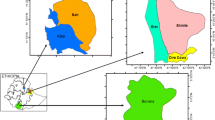Summary
The epidemiology of trypanosomiasis in a tsetse-infested range area of Kenya was studied for 2 years in various breeds of sheep and goats. Observations, including infection rates, PCV, temperature and weight loss indicated that the exotic breeds were more susceptible to natural trypanosomal infection than the indigenous breeds and that the infection may be severely debilitating and in many cases fatal.
Observations of tsetse numbers and rainfall in the grazing area during the first year showed that there was a significant correlation between tsetse numbers and rainfall of the previous month. The increase in tsetse numbers, which occurred one month after substantial rainfall, was followed by an increase in the prevalence of trypanosomiasis in the animals. However, during the second year when rainfall was low there was no correlation between tsetse numbers and rainfall.
It was concluded that the seasonal incidence of trypanosomiasis and the possible trypanotolerance of the indigenous breeds are important factors to be considered when initiating a small stock improvement programme for trypanosomiasis-endemic areas.
Résumé
L'épidemiologie des trypanosomoses chez diverses races de moutons et de chèvres des régions infestées de tsé-tsé du Kenya a été étudiée pendant 2 ans. Les observations, comprenant les taux d'infestations, le P.C.V., la température, les pertes de poids, indiquent que les animaux de races exotiques sont plus sensibles aux trypanosomoses naturelles que les races locales et que chez eux les atteintes de la maladie se traduisent par des manifestations gravement débilitantes et dans de nombreux cas fatales.
Les observations sur le nombre de tsé-tsé et les chutes de pluies dans les régions pâturées durant la première année ont montré qu'il existait une corrélation positive entre l'effectif des glossines et les chutes de pluies du mois précédent. A l'accroissement du nombre de tsé-tsé intervenant un mois après des pluies abondantes répondait un accroissement des trypanosomoses chez les animaux. Toutefois durant la seconde année où les pluies ont été peu abondantes on n'a observé aucune corrélation entre le nombre de tsé-tsé et les précipitations.
Les auteurs concluent que l'incidence saisonnière des trypanosomoses et la possible trypanotolérance du bétail indigène sont des facteurs importants à considérer lors d'études de programmes d'installation de petits élevages dans les régions ou les trypanosomoses régnent à l'état endémique.
Resumen
Se estudió la epidemiología de la tripanosomiasis en varias razas de ovejas y cabras en un área infestada por moscas tsetse en Kenia. El estudio duró dos años los cuales incluyeron observaciones sobre la tasa de infección, hematocrito, temperatura y pérdida de peso. Los resultados indicaron que las razas exóticas fueron más susceptibles a la infección natural y que la enfermedad puede llegar a ser severa y debilitante causando la muerte en no pocas ocasiones.
Las observaciones sobre el número de moscas tsetse en relación con el régimen de lluvias en el área de pastoreo durante el primer año, mostró correlación entre el número de moscas y la ocurrencia de lluvias en el mes anterior. El incremento del número de moscas tsetse 1 mes despues de las lluvias coincidio tambien con el incremento de tripanosomiasis en los animales. Sin embargo, durante el segundo año cuando las lluvias no fueron fuertes, no hubo correlación alguna entre número de moscas y lluvias.
Se concluyó, que la incidencia estacional de tripanosomiasis y la posible tripanotolerancia de las razas indigenas son factores importantes que deben considerarse cuando se inicien programas de mejoramiento de razas en áreas endémicas de tripanosomiasis.
Similar content being viewed by others
References
Fairbairn, H. (1950).Annals of Tropical Medicine and Parasitology,44, 27–33.
Hoare, C. A. (1972).The Trypanosomes of Mammals. Blackwell, Oxford.
Jackson, C. H. N. (1940). An outline of experiments at Kakoma.Tsetse Research Report 1935–38. Tanganyika Territory, Dar es Salaám pp. 11–18.
Kramer, J. (1966).Bulletin of Epizootic Diseases of Africa,14, 423.
Losos, G. J. &Ikede, B. O. (1972).Journal of Veterinary Pathology,9 (Supplement), 1–71.
MacLennan, K. J. R. (1970). The epizootiology of trypanosomiasis in livestock in West Africa. InThe African Trypanosomiases (ed. Mulligan). pp. 751–773, George Allen and Unwin, London.
Nash, T. A. M. (1933).Journal of Animal Ecology,2, 197–203.
Nash, T. A. M. (1937).Bulletin of Entomological Research,8, 75–127.
Potts, W. H. (1930).South African Journal of Science,27, 491–497.
Pratt, D. J., Greenway, P. J. &Gwynne, M. D. (1966).Journal of Applied Ecology,3, 369–382.
Squire, F. A. (1951).Bulletin of Entomological Research,42, 371–374.
Stephen, L. E. (1970). Clinical manifestations of the trypanosomiases in livestock and other domestic animals. InThe African Trypanosomiases (ed. Mulligan), pp. 774–792, George, Allen and Unwin, London.
Author information
Authors and Affiliations
Additional information
Animal Health and Production Officer, UNDP/FAO Sheep and Goat Development Project.
Rights and permissions
About this article
Cite this article
Griffin, L., Allonby, E.W. Studies on the epidemiology of trypanosomiasis in sheep and goats in Kenya. Trop Anim Health Prod 11, 133–142 (1979). https://doi.org/10.1007/BF02237789
Accepted:
Issue Date:
DOI: https://doi.org/10.1007/BF02237789




